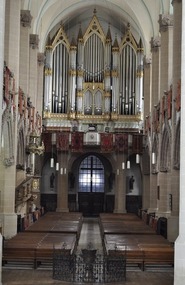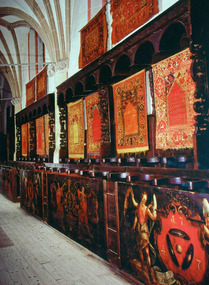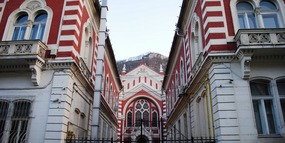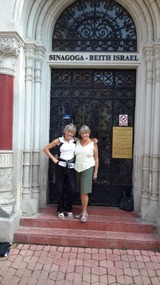August 31 – Sept. 2…Octoberfest in August, visiting more villages, then back to Bulgaria and the Black Sea
We took it easy for the first part of the next day
. Pam and Miles had found a tennis court close by and went to play while I worked on the Blogs and Bill researched things to do in our next location.
That afternoon, we all went into Brasov to tour the interior of the Black Church. Our little tour guide didn't steer us wrong as the huge pipe organ was, indeed, a sight to see and the Turkish rugs, hanging almost the entire length of the church walls, were very impressive. After the Black Church, we went to see the Jewish Synagogue.
Jews have been in Brasov since 1807, when Aron Ben Jehuda was given permission by the until then restrictive Saxons to live in the city. The Jewish Community of Brasov was officially founded 19 years later, followed by the first Jewish school in 1864 and building of the synagogue in 1901. The Jewish population of Brasov expanded rapidly to a population of 1280 in 1910 and to 4,000 in 1940. Today the community has about 230 members, after many families left for Israel between WWII and 1989.
Right outside the synagogue is the Brasov, Romania Holocaust Memorial. Of the three hundred and eighty thousand Romanians killed by the Nazis, 150,000 were Romanian Jews. The Jews of Brasov suffered more than any other group of people and the Brasov, Romania Holocaust Memorial is a powerful reminder to us all of their suffering and sacrifice.
Next,To lighten the mood, we went over to the Octoberfest that was happening in a big space right outside the old city
. Although October was a month away, Brasov holds this festival every year at the end of August to the first part of September, before the kids go back to school. It was very festive with lots of booths with delicious looking food, and areas of picnic tables where you could enjoy your meal and a beer while listening to music blaring over the loud speaker. We chose our food and, I have to admit, it looked better than it tasted as a lot of the sausages and potatoes that we got were cold. Then, we wandered into the big arena that was set up for the entertainment. What fun watching the dancing and the spectators, all being very raucous and having a great time. On our way back to the car, we stopped for an ice cream that was as good as it looked. It felt nice to have a more mellow day and get rested up for the following day when we would do more driving to visit two more villages.
Sept. 1…Sighisoara and Viscri
We left the next morning to drive about an hour and a half to the fortified village of Sighisoara that stands as one of the most preserved medieval villages in Europe. The roots of the charming village date back to the 12th century when German craftsmen and merchants, known as the Transylvanian Saxons, were invited to Transylvania by the King of Hungary to settle and defend the frontier of his realm. There are documents that list a Saxon settlement in present-day Sighisoara by 1191 and by 1337 Sighisoara had become a royal center for the kings, who awarded the settlement urban status in 1367
.
The city played an important strategic and commercial role at the edges of Central Europe for several centuries. Sighisoara became one of the most important cities of Transylvabnia with artisans from throughout the Holy Roman Empire visiting the settlement. It was also the birthplace of Vlad the Impaler…Dracula, in Bram Stokers’ novel, and, not only is there a large bronze bust of him in one of the squares, there’s a popular Dracula Restaurant where we stopped for lunch. Afterwards, we wandered around the town, admiring the imposing clock tower and buying a few wooden pieces in a wonderful and unique little gift shop that we stumbled upon.
Next, we drove to the much smaller village of Viscri, famous for the fortified church built in 1100. After driving for about 30 minutes on a narrow dirt road, filled with pot holes, we almost turned back as we couldn’t image there could be a village anywhere on this remote road. Then, out of nowhere, there was the village that was all of about eight blocks, total
. The church was at the upper end of the village so we had no trouble finding it. This very simple and unique structure was built by the ethnic German Transylvanian Saxon community at a time when the area belonged to the Kingdom on Hungary. Initially Roman Catholic, it became Lutheran following the Reformation. Together with the surrounding village, the church forms part of the village with fortified churches in Transylvania UNESCO World Heriitage Site. Pretty fancy name for a very simple structure.
We spent quite a bit of time wandering through the different sections of the church and climbing up to the tower that offered beautiful views of the landscape below and of the little cemetery. There was also three levels of exhibits displaying the furnishings during that period and very interesting farming implements as well as looms used to make their textiles.
This unique little church was such a nice change from the grandiose and elaborately constructed cathedrals we had seen in the other countries we had visited. The magnificent hills and valleys and quaint village provided a very different kind of grandeur to this simple but beautiful church and I was very glad that we didn’t give up and turn back without seeing the fortified church of Viscri.
When we arrived back in Brasov, Bill and Miles went back over to the Octoberfest to get a bite to eat but Pam and I opted to eat at one of the outdoor cafes on the square. The guys joined us there when they were finished and we all went back to "palace bizarro" to pack our things as we were leaving in the morning to drive to the Black Sea and to our next home exchange.
OCTOBERFEST, SIGHISOARA THEN THE BLACK SEA
Wednesday, August 31, 2016
 Sighisoara, Transylvania, Romania
Sighisoara, Transylvania, Romania
Other Entries
-
17WE WELCOMED THE CHANGE OF PACE
Aug 1021 days prior Horní Polubný, Czech Republicphoto_camera32videocam 0comment 4
Horní Polubný, Czech Republicphoto_camera32videocam 0comment 4 -
18THE GLASS FACTORY AND CROSSING INTO POLAND
Aug 1219 days prior Horní Polubný, Czech Republicphoto_camera17videocam 0comment 0
Horní Polubný, Czech Republicphoto_camera17videocam 0comment 0 -
19POLAND AND BACK...FOR REAL
Aug 1318 days prior Karpacz, Polandphoto_camera23videocam 0comment 7
Karpacz, Polandphoto_camera23videocam 0comment 7 -
20OFF ON ANOTHER DAY EXCURSION TO LIBEREC
Aug 1417 days prior Liberec, Czech Republicphoto_camera33videocam 0comment 11
Liberec, Czech Republicphoto_camera33videocam 0comment 11 -
21VISITING THE ROCK CASTLES
Aug 1516 days prior Malá Skála, Czech Republicphoto_camera40videocam 0comment 3
Malá Skála, Czech Republicphoto_camera40videocam 0comment 3 -
22GOODBYE TO HORNI POLUBNY AND OFF TO VENICE
Aug 1615 days prior Prague, Czech Republicphoto_camera27videocam 0comment 0
Prague, Czech Republicphoto_camera27videocam 0comment 0 -
23FINALLY IN A NEW COUNTRY
Aug 1813 days prior Vienna, Austriaphoto_camera24videocam 0comment 4
Vienna, Austriaphoto_camera24videocam 0comment 4 -
24ALBERTINA, SCHONBRUNN AND THE FABULOUS ZOO
Aug 1912 days prior Vienna, Austriaphoto_camera29videocam 1comment 3
Vienna, Austriaphoto_camera29videocam 1comment 3 -
25SO MUCH TO SEE AND DO....AND IT'S PAM'S BIRTHDAY
Aug 2011 days prior Vienna, Austriaphoto_camera46videocam 0comment 1
Vienna, Austriaphoto_camera46videocam 0comment 1 -
26MORE SIGHTS TO SEE ON ROD'S BIRTHDAY
Aug 2110 days prior Vienna, Austriaphoto_camera24videocam 0comment 0
Vienna, Austriaphoto_camera24videocam 0comment 0 -
27OUR FINAL FULL DAY IN VIENNA
Aug 229 days prior Vienna, Austriaphoto_camera16videocam 0comment 1
Vienna, Austriaphoto_camera16videocam 0comment 1 -
28A NEW ADVENTURE....A NEW COUNTRY
Aug 238 days prior Yastrebets, Russian Federationphoto_camera47videocam 1comment 1
Yastrebets, Russian Federationphoto_camera47videocam 1comment 1 -
29NOW WE'RE IN ROMANIA...WE SURE GET AROUND
Aug 265 days prior Brasov, Romaniaphoto_camera22videocam 0comment 4
Brasov, Romaniaphoto_camera22videocam 0comment 4 -
30WALKING TOUR IN BRASOV
Aug 274 days prior Brasov, Romaniaphoto_camera18videocam 0comment 0
Brasov, Romaniaphoto_camera18videocam 0comment 0 -
31ALL I CAN SAY IS.....BIZARRE
Aug 283 days prior Sacele, Romaniaphoto_camera18videocam 0comment 2
Sacele, Romaniaphoto_camera18videocam 0comment 2 -
32PHOTO JOURNAL OF OUR SACELE HOME EXCHANGE
Aug 292 days prior Săcele, Romaniaphoto_camera18videocam 0comment 5
Săcele, Romaniaphoto_camera18videocam 0comment 5 -
33VISITING THE LOVELY TOWN OF SINAIA
Aug 301 day prior Sinaia, Romaniaphoto_camera26videocam 0comment 1
Sinaia, Romaniaphoto_camera26videocam 0comment 1 -
34OCTOBERFEST, SIGHISOARA THEN THE BLACK SEA
Aug 31 Sighisoara, Romaniaphoto_camera39videocam 0comment 3
Sighisoara, Romaniaphoto_camera39videocam 0comment 3 -
35ANOTHER COUNTRY, ANOTHER HOME EXCHANGE
Sep 022 days later Kosharitsa, Bulgariaphoto_camera29videocam 0comment 2
Kosharitsa, Bulgariaphoto_camera29videocam 0comment 2 -
36THE ENCHANTING VILLAGE OF SOZOPOL
Sep 044 days later Sozopol, Bulgariaphoto_camera34videocam 0comment 4
Sozopol, Bulgariaphoto_camera34videocam 0comment 4 -
37WE'RE ON OUR OWN
Sep 066 days later Sveti Vlas, Bulgariaphoto_camera12videocam 0comment 2
Sveti Vlas, Bulgariaphoto_camera12videocam 0comment 2 -
38LAST FEW DAYS IN EASTERN EUROPE
Sep 077 days later Sveti Vlas, Bulgariaphoto_camera21videocam 0comment 6
Sveti Vlas, Bulgariaphoto_camera21videocam 0comment 6 -
39MYSTERY OF THE MISSING LUGGAGE
Sep 1010 days later Istanbul, Turkeyphoto_camera5videocam 0comment 1
Istanbul, Turkeyphoto_camera5videocam 0comment 1 -
40SENSORY OVERLOAD
Sep 1111 days later Istanbul, Turkeyphoto_camera31videocam 0comment 9
Istanbul, Turkeyphoto_camera31videocam 0comment 9 -
41TAKSIM SQUARE AND THE POTATO SEARCH
Sep 1212 days later Istanbul, Turkeyphoto_camera34videocam 0comment 3
Istanbul, Turkeyphoto_camera34videocam 0comment 3 -
42MAYBE THIS IS WHAT IT LOOKS LIKE ON THE MOON
Sep 1313 days later Nevsehir, Turkeyphoto_camera29videocam 1comment 6
Nevsehir, Turkeyphoto_camera29videocam 1comment 6 -
43DAY TWO - CAPPADOCIA
Sep 1414 days later Nevsehir, Turkeyphoto_camera32videocam 0comment 5
Nevsehir, Turkeyphoto_camera32videocam 0comment 5 -
44LAST TWO DAYS IN ISTANBUL
Sep 1515 days later Istanbul, Turkeyphoto_camera29videocam 0comment 3
Istanbul, Turkeyphoto_camera29videocam 0comment 3 -
45CAIRO AND OUR FABULOUS NILE RIVER CRUISE
Sep 1717 days later Cairo, Egyptphoto_camera24videocam 0comment 5
Cairo, Egyptphoto_camera24videocam 0comment 5 -
46OUR NILE EXCURSION CONTINUES
Sep 1919 days later Luxor, Egyptphoto_camera35videocam 0comment 6
Luxor, Egyptphoto_camera35videocam 0comment 6 -
47VALLEY OF THE KINGS
Sep 2020 days later Luxor, Egyptphoto_camera34videocam 0comment 8
Luxor, Egyptphoto_camera34videocam 0comment 8 -
48EDFU AND KOM OMBO
Sep 2121 days later Aswān, Egyptphoto_camera36videocam 0comment 5
Aswān, Egyptphoto_camera36videocam 0comment 5 -
49OUR LAST FULL DAY ON THE NILE EXCURSION
Sep 2222 days later Aswān, Egyptphoto_camera32videocam 0comment 4
Aswān, Egyptphoto_camera32videocam 0comment 4 -
50THE AIRPORT FIASCO
Sep 2323 days later Addis Ababa, Ethiopiaphoto_camera23videocam 0comment 4
Addis Ababa, Ethiopiaphoto_camera23videocam 0comment 4 -
51THE MESKEL FESTIVAL
Sep 2626 days later Addis Ababa, Ethiopiaphoto_camera29videocam 4comment 1
Addis Ababa, Ethiopiaphoto_camera29videocam 4comment 1 -
52THE ASTOUNDING CHURCHES OF LALIBELA
Sep 2828 days later Lalibela, Ethiopiaphoto_camera42videocam 0comment 2
Lalibela, Ethiopiaphoto_camera42videocam 0comment 2

 Sighisoara, Transylvania, Romania
Sighisoara, Transylvania, Romania















































2025-05-22